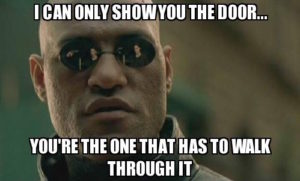Ujjayi Pranayama means “victorious breath.” It is often practiced through the entirety of an ashtanga or flow yoga class. It is meant to be calming and rhythmic and help the practitioner focus. Slow, deep inhales followed by long, exhales of roughly the same length. The defining characteristic is the wheezy, ocean-like sound. Ujjayi is an audible breath performed by constricting the throat and tongue slightly while breathing in and out through your nose.
Try this. Sit up straight. Close your eyes. Take a breath in through your nose and exhale out through your mouth and whisper “hahhh”. Feel where it vibrates the back of the throat. Take another breath in through your nose and whisper “hahhh” but press the tongue to the roof of your mouth. Feel where your tongue touches the palate and how the jaw constricts slightly. That’s basically the shape you want for your mouth. Take another deep inhale though the nose and exhale though the nose while retaining the sound. Keep doing this while taking slow, deep abdominal-thoracic breaths.
Ujjayi Pranayama from Force Distance Time on Vimeo.
I personally find it relaxing to perform ujjayi breaths and will consciously or unconsciously start doing it when I take deep breaths to relax or when I meditate. Because the breath is audible, you can focus on it better and thus counting your breaths and the length of your breaths becomes much easier. Because you are restricting the flow of air, you naturally breathe much slower with ujjayi breath and consequently much deeper.
One thing that I rarely hear mentioned about ujjayi breathing is the fact that it aides in spinal stabilization. The throat acts like a valve on abdominal-thoracic cavity. True abdominal bracing is done by creating pressure between the diaphragm and the perineum. However, the slight restriction on the breath helps create pressure as well. In situations where breath holding is ill-advised but some intra-abdominal pressure is necessary, ujjayi breath is a strong choice.

